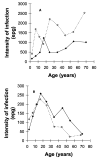Contrasting patterns in the small-scale heterogeneity of human helminth infections in urban and rural environments in Brazil
- PMID: 16814294
- PMCID: PMC1783908
- DOI: 10.1016/j.ijpara.2006.05.009
Contrasting patterns in the small-scale heterogeneity of human helminth infections in urban and rural environments in Brazil
Abstract
Marked heterogeneity exists in the patterns of parasitic infection between individuals, households and communities. Analysis of parasite distributions within populations is complicated by the fact that parasite distributions are highly aggregated and few studies have explicitly incorporated this distribution when investigating small-scale spatial heterogeneities. This study aimed to quantify the small-scale (within- and between-household) heterogeneity of helminth infection in an area of Minas Gerais State, Brazil, with rural and urban sectors. Parasitological data from a cross-sectional survey of 1,249 individuals aged 0-86 years from 242 households were analysed. Within-household clustering of infection was assessed using random effect logistic regression models and between-household spatial heterogeneity was assessed using a Bayesian negative binomial spatial model. The overall prevalence of hookworm (Necator americanus) was 66.9%, the prevalence of Schistosoma mansoni was 44.9% and the prevalence of Ascaris lumbricoides was 48.8%. Statistical analysis indicated significant (within) household and (between household) spatial clustering of hookworm in both rural and urban areas and of S. mansoni in rural areas. There was no evidence of either household or spatial clustering of S. mansoni in urban areas. The spatial correlation of S. mansoni was estimated to reduce by half over a distance of 700 m in the rural area. Rural hookworm had a much smaller half-distance (28 m) and urban hookworm showed an even smaller half-distance (12 m). We suggest that such species-specific differences in patterns of infection by environment are primarily due to variation in exposure and parasite life cycle, although host genetic factors cannot be ruled out.
Figures



Similar articles
-
Synergistic associations between hookworm and other helminth species in a rural community in Brazil.Trop Med Int Health. 2006 Jan;11(1):56-64. doi: 10.1111/j.1365-3156.2005.01541.x. Trop Med Int Health. 2006. PMID: 16398756
-
Human helminth co-infection: no evidence of common genetic control of hookworm and Schistosoma mansoni infection intensity in a Brazilian community.Int J Parasitol. 2010 Mar 1;40(3):299-306. doi: 10.1016/j.ijpara.2009.08.002. Epub 2009 Aug 20. Int J Parasitol. 2010. PMID: 19699204 Free PMC article.
-
Human helminth co-infection: analysis of spatial patterns and risk factors in a Brazilian community.PLoS Negl Trop Dis. 2008;2(12):e352. doi: 10.1371/journal.pntd.0000352. Epub 2008 Dec 23. PLoS Negl Trop Dis. 2008. PMID: 19104658 Free PMC article.
-
Current epidemiological evidence for predisposition to high or low intensity human helminth infection: a systematic review.Parasit Vectors. 2018 Jan 31;11(1):65. doi: 10.1186/s13071-018-2656-4. Parasit Vectors. 2018. PMID: 29382360 Free PMC article.
-
Socioeconomic studies of schistosomiasis in Brazil: a review.Acta Trop. 2008 Nov-Dec;108(2-3):194-201. doi: 10.1016/j.actatropica.2008.07.002. Epub 2008 Jul 23. Acta Trop. 2008. PMID: 18694715 Free PMC article. Review.
Cited by
-
Spatial epidemiology of human schistosomiasis in Africa: risk models, transmission dynamics and control.Trans R Soc Trop Med Hyg. 2007 Jan;101(1):1-8. doi: 10.1016/j.trstmh.2006.08.004. Epub 2006 Oct 20. Trans R Soc Trop Med Hyg. 2007. PMID: 17055547 Free PMC article. Review.
-
Estimation of the burden of active and life-time epilepsy: a meta-analytic approach.Epilepsia. 2010 May;51(5):883-90. doi: 10.1111/j.1528-1167.2009.02481.x. Epub 2010 Jan 7. Epilepsia. 2010. PMID: 20067507 Free PMC article.
-
Prediction of hookworm prevalence in southern India using environmental parameters derived from Landsat 8 remotely sensed data.Int J Parasitol. 2020 Jan;50(1):47-54. doi: 10.1016/j.ijpara.2019.10.001. Epub 2019 Nov 20. Int J Parasitol. 2020. PMID: 31756313 Free PMC article.
-
Individual predisposition, household clustering and risk factors for human infection with Ascaris lumbricoides: new epidemiological insights.PLoS Negl Trop Dis. 2011 Apr 26;5(4):e1047. doi: 10.1371/journal.pntd.0001047. PLoS Negl Trop Dis. 2011. PMID: 21541362 Free PMC article.
-
Genetic diversity and population structuring of Schistosoma mansoni in a Brazilian village.Int J Parasitol. 2008 Mar;38(3-4):389-99. doi: 10.1016/j.ijpara.2007.07.011. Epub 2007 Aug 6. Int J Parasitol. 2008. PMID: 17825305 Free PMC article.
References
-
- Alexander N, Moyeed R, Stander J. Spatial modelling of individual-level parasite counts using the negative binomial distribution. Biostatistics. 2000;1:453–463. - PubMed
-
- Anderson RM. Determinants of infection in human schistosomiasis. In: Mahmound AF, editor. Balillière's Clinical Tropical Medicine and Communicable Disease. 2nd edn. Balillière Tindall; London: 1987. pp. 279–300.
-
- Anderson RM, May RM. Infectious Diseases of Humans: dynamics and control. Oxford University Press; Oxford: 1991.
-
- Anderson RM. Epidemiology. In: Cox F.E.G. Cox., editor. Modern Parasitology. Blackwell; Oxford: 1991. pp. 75–116.
Publication types
MeSH terms
Grants and funding
LinkOut - more resources
Full Text Sources
Medical

